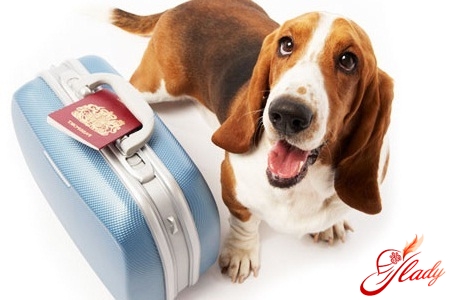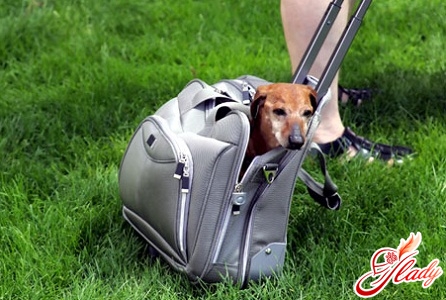 Vacation is the best "time of the year".This is an opportunity to break out of the usual circle, get new impressions and fulfill long-standing dreams. Vacation is the perfect time to travel. You are looking forward to the trip, planning the route, writing a list of necessary things ... and suddenly you come across the devoted, loving gaze of your dog. Where to put it during the vacation? It is good if you have a close and dear person whom both you and your pet trust. Then consider the problem solved. Just leave the dog with him - it will be calmer for both you and your pet. But what if there is no such person? Traveling with a dog is a serious matter and you need to prepare for it in advance. If you are going on a trip to Russia, then taking your dog with you will be quite simple. A minimum of documents is required - a veterinary passport and veterinary certificate No. 1. With trips abroad, everything is much more complicated.
Vacation is the best "time of the year".This is an opportunity to break out of the usual circle, get new impressions and fulfill long-standing dreams. Vacation is the perfect time to travel. You are looking forward to the trip, planning the route, writing a list of necessary things ... and suddenly you come across the devoted, loving gaze of your dog. Where to put it during the vacation? It is good if you have a close and dear person whom both you and your pet trust. Then consider the problem solved. Just leave the dog with him - it will be calmer for both you and your pet. But what if there is no such person? Traveling with a dog is a serious matter and you need to prepare for it in advance. If you are going on a trip to Russia, then taking your dog with you will be quite simple. A minimum of documents is required - a veterinary passport and veterinary certificate No. 1. With trips abroad, everything is much more complicated.
We go abroad
Before you take your four-legged friendwith you abroad, you need to contact the consulate of the country you are going to. Already at this stage, serious problems can arise. The rules for importing dogs into different countries are very different. Some countries prohibit the import of fighting dogs and other aggressive breeds. Many countries prohibit the import of puppies under 3 months of age. All these points need to be clarified "on the shore", otherwise you risk getting into a very unpleasant situation - you will be released from Russia, but you will not be able to enter the country of arrival. And what will you do at the border with your pet? In addition, some countries have a quarantine. For example, in the UK, the quarantine period is 6 months. Therefore, if you are going on vacation to England for just a couple of weeks, taking your animal with you makes no sense - you will be separated anyway. If you did not find any restrictions regarding your "beast" in the legislation of the country - we move on. Check for any required vaccinations - some countries require additional ones against certain infectious diseases.
Test for the presence of antibodies to rabies
When entering many countries - for example,Ireland, Sweden, Great Britain and some others may require the results of a rabies antibody test. You should prepare for this in advance - it is unlikely that you will be able to do the test and get the results in 2-3 days. The fact is that only laboratories accredited by the EEC have the right to do such a test. In Russia, there is one such laboratory - it is located in Moscow. It is also possible to send a blood test of your pet to a laboratory located in Finland. If the antibody content is less than 0.5 IU / ml, then the animal will need to be re-vaccinated against rabies, and then, after 3 months, repeat the antibody test. If the test is passed successfully, then you will not have to take it again - the result has no expiration date. Of course, if you do not miss the next vaccination. Got it? Good.
Chipping
If you are traveling with a dogin Europe, then this procedure is mandatory for you. You can get microchipped in almost all state veterinary clinics in Russia. A small electronic chip - the size of a grain of rice - is injected subcutaneously. The chip contains unique information about your animal, which is entered into an electronic database. Microchipping is no more dangerous than a regular subcutaneous injection. The chip stays with the animal for life - it cannot be lost or damaged. At the same time, it is absolutely harmless and does not interfere with the animal - it simply does not feel it. Carefully study all of your pet's documents. You have them, right? What else should be mandatory?
International Veterinary Passport
For traveling abroad with a dog, absolutelyan international veterinary passport is required. Make sure that the passport is international - there is a certain standard. It is filled out in English. It contains all the information about you - the owner - and your pet. There should be dates of the last treatment for endoparasites and ectoparasites - in other words, fleas and worms. Particular attention should be paid to vaccinations. They should be done with vaccines that meet international standards. Be sure to pay attention to the dates of vaccinations. All vaccinations must be done at least 30 days before your departure. If the vaccine is about to expire, it is better to get a revaccination. Particular attention should be paid to rabies vaccinations. If they are not included in the passport, the animal will be immediately deported from the country. And if this is impossible, it can be euthanized. Also make sure that the chipping data is entered in the veterinary passport. Are all the documents in order? Great!
Export license
The problem here is the same as with the antibody test.— you can only get a license in Moscow. Depending on the breed of the dog, you will need to contact the Russian Cynological Association (RCA), the Central Club of Service Dog Breeding (CCSS) or the Russian Hunting and Fishing Union. However, if the dog has a pedigree, then you will not need to show the "product in person". It is enough to simply provide a document. If there is no pedigree, you will have to take the "beast" on an excursion to Moscow.
Tickets for animals
When purchasing or booking tickets,Be sure to inform that you will be “accompanied” by a four-legged friend. This is especially true when traveling with a dog on an airplane. Many airlines have a rule that no more than two animals can be on board at the same time. Therefore, it is imperative to “insure yourself”. What if someone has already booked seats for “furry passengers”? Check with your airline for the rules for transporting animals. Although they are approximately the same, each company has the right to make minor changes. First of all, they concern the maximum permissible size of the transport cage. These “minor” changes can become a very big problem if you are not prepared in advance.
Cage-transportation
By the way, the presence of a cage - transportation withwaterproof bottom — a general requirement. A waterproof "dog" diaper must be placed on the bottom of the container. However, a regular baby diaper will do. If your pet weighs less than 8 kilograms, it will most likely be allowed to be taken into the cabin of the plane. The exceptions are flights going through Miami, Irish Shannon and cities in Germany. They strictly prohibit transporting animals in the cabin. Large dogs are forced to travel in the luggage compartment. Moreover, before departure they are given a sleeping pill. All animals must have a leash, collar and muzzle. Of course, it is difficult to imagine a Chinese Crested or Yorkie in a muzzle — and, as a rule, no one forces you to do this. But, since this is spelled out in the rules, it is better to buy this "accessory". Then you will have the opportunity to "present" it at the first request. Why create unnecessary problems, right? If you are not going to sit in one place during your vacation, but are planning to travel with your dog around Europe, you need to once again clarify the rules for transporting animals adopted in a given country. Each country has its own nuances. For example, in Sweden, Macedonia, Croatia, Slovenia and Yugoslavia, dogs are not allowed on rail transport. And in Finland, you will be required to buy out all the seats in the compartment. In any case, be prepared to pay a baggage ticket for your pet. Tariffs are different everywhere - they are set by the carrier company. But even if your pet weighs only a couple of kilograms, its weight will not be included in the free baggage allowance - you will have to pay separately. In order to insure yourself against unpleasant surprises on the day of departure, it is better to weigh the dog in advance together with the cage, clarify the carrier's tariffs and prepare the required amount - and with a small reserve.
Veterinary certificate number 1
Whether you are heading toIf you are traveling with a dog in Russia, Asia, America, Australia or Europe, you will still need veterinary certificate #1. This is the main document for a traveling dog. It must be issued 3 days before departure. You can get this certificate at any state veterinary clinic in your city. In order not to waste time, find out in advance whether you need to bring your pet with you. In some places, you can get a certificate based on a veterinary passport, in others - you need to show the dog to the doctor. When issuing a certificate, make sure that all the data on you and your dog is entered there, including the exact route of your trip.
Border crossing
On the day of departure you will need to go throughcustoms veterinary control. Therefore, you need to arrive at the airport in advance - there are often long queues to see the veterinarian. Show the doctor all the papers that you have been collecting for so long and painfully:
- international veterinary passport;
- veterinary certificate No. 1;
- the results of a test for antibodies to rabies;
- license to export an animal.
If you did everything correctly, there will be no problems.will be - they will simply exchange the veterinary certificate received at the clinic for another one of the international standard. With this document, go to the registration. There they will weigh the dog together with the cage and you will pay for the "dog ticket". Everything - the way is open! You and your dog are completely ready for the trip!
"Doggy" trivia
What else do you need to take care of when going?Traveling with a dog? If the trip is long, be sure to take 2-3 waterproof diapers with you. Moreover, you need to put them in such a way that they are at hand at any time. Animals get nervous in unfamiliar surroundings and such "supplies" can be very useful. Some dogs get sick in transport. Here, too, you need to be "fully armed". Keep a plastic bag nearby - you can even 2-3 pieces. Be sure to take wet wipes. In case of trouble, all this will help you quickly "liquidate the consequences". It is advisable to have a small bottle of water with you. Especially in hot weather. It is better to buy water at the airport, after passing through security - otherwise they will make you throw it away. Special "hiking" dog bowls are very convenient for traveling. They are made of food-grade plastic and fold conveniently, practically taking up no space. Take care of the "food". If your pet is used to a certain type of dry food, it is better to take it with you. It is not always possible to find exactly the same one abroad. The trip itself is already a lot of stress for the animal. If you also change the food, the dog may simply get sick. Do you need this on vacation? Have you changed your mind about traveling with a dog yet? Then let your trip be pleasant and interesting. After all, vacation usually only happens once a year.









